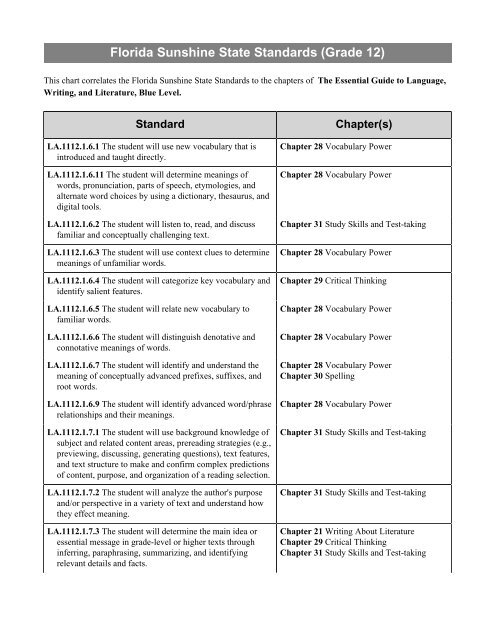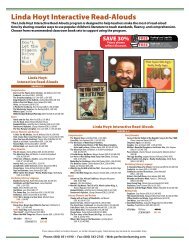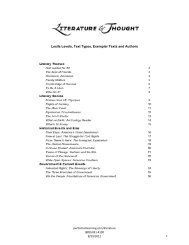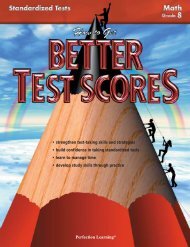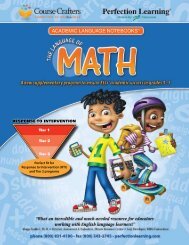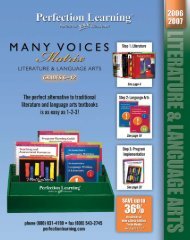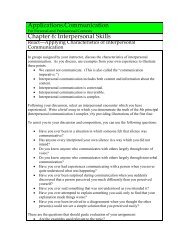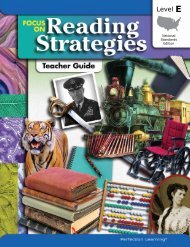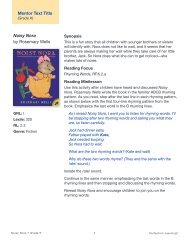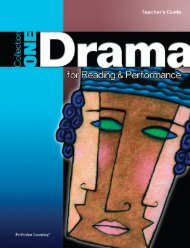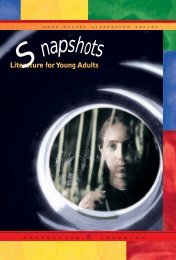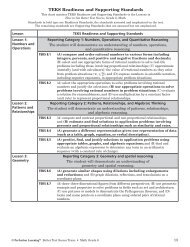Florida Sunshine State Standards (Grade 12) - Perfection Learning
Florida Sunshine State Standards (Grade 12) - Perfection Learning
Florida Sunshine State Standards (Grade 12) - Perfection Learning
Create successful ePaper yourself
Turn your PDF publications into a flip-book with our unique Google optimized e-Paper software.
<strong>Florida</strong> <strong>Sunshine</strong> <strong>State</strong> <strong>Standards</strong> (<strong>Grade</strong> <strong>12</strong>)<br />
This chart correlates the <strong>Florida</strong> <strong>Sunshine</strong> <strong>State</strong> <strong>Standards</strong> to the chapters of The Essential Guide to Language,<br />
Writing, and Literature, Blue Level.<br />
Standard<br />
LA.11<strong>12</strong>.1.6.1 The student will use new vocabulary that is<br />
introduced and taught directly.<br />
LA.11<strong>12</strong>.1.6.11 The student will determine meanings of<br />
words, pronunciation, parts of speech, etymologies, and<br />
alternate word choices by using a dictionary, thesaurus, and<br />
digital tools.<br />
LA.11<strong>12</strong>.1.6.2 The student will listen to, read, and discuss<br />
familiar and conceptually challenging text.<br />
LA.11<strong>12</strong>.1.6.3 The student will use context clues to determine<br />
meanings of unfamiliar words.<br />
LA.11<strong>12</strong>.1.6.4 The student will categorize key vocabulary and<br />
identify salient features.<br />
LA.11<strong>12</strong>.1.6.5 The student will relate new vocabulary to<br />
familiar words.<br />
LA.11<strong>12</strong>.1.6.6 The student will distinguish denotative and<br />
connotative meanings of words.<br />
LA.11<strong>12</strong>.1.6.7 The student will identify and understand the<br />
meaning of conceptually advanced prefixes, suffixes, and<br />
root words.<br />
LA.11<strong>12</strong>.1.6.9 The student will identify advanced word/phrase<br />
relationships and their meanings.<br />
LA.11<strong>12</strong>.1.7.1 The student will use background knowledge of<br />
subject and related content areas, prereading strategies (e.g.,<br />
previewing, discussing, generating questions), text features,<br />
and text structure to make and confirm complex predictions<br />
of content, purpose, and organization of a reading selection.<br />
LA.11<strong>12</strong>.1.7.2 The student will analyze the author's purpose<br />
and/or perspective in a variety of text and understand how<br />
they effect meaning.<br />
LA.11<strong>12</strong>.1.7.3 The student will determine the main idea or<br />
essential message in grade-level or higher texts through<br />
inferring, paraphrasing, summarizing, and identifying<br />
relevant details and facts.<br />
Chapter(s)<br />
Chapter 28 Vocabulary Power<br />
Chapter 28 Vocabulary Power<br />
Chapter 31 Study Skills and Test-taking<br />
Chapter 28 Vocabulary Power<br />
Chapter 29 Critical Thinking<br />
Chapter 28 Vocabulary Power<br />
Chapter 28 Vocabulary Power<br />
Chapter 28 Vocabulary Power<br />
Chapter 30 Spelling<br />
Chapter 28 Vocabulary Power<br />
Chapter 31 Study Skills and Test-taking<br />
Chapter 31 Study Skills and Test-taking<br />
Chapter 21 Writing About Literature<br />
Chapter 29 Critical Thinking<br />
Chapter 31 Study Skills and Test-taking
Essential Guide to Language, Writing, and Literature, Blue Level / <strong>Florida</strong> <strong>Sunshine</strong> <strong>State</strong> <strong>Standards</strong> Correlation - p. 2<br />
Standard<br />
LA.11<strong>12</strong>.1.7.8 The student will use strategies to repair<br />
comprehension of grade-appropriate text when selfmonitoring<br />
indicates confusion, including but not limited to<br />
rereading, checking context clues, predicting, note-making,<br />
summarizing, using graphic and semantic organizers,<br />
questioning, and clarifying by checking other sources.<br />
LA.11<strong>12</strong>.2.1.10 The student will select a variety of ageand<br />
ability-appropriate fiction materials to read based on<br />
knowledge of authors' styles, themes, and genres to expand<br />
the core foundation of knowledge necessary to connect<br />
topics and function as a fully literate member of a shared<br />
culture.<br />
LA.11<strong>12</strong>.2.1.2 The student will read, analyze, and compare a<br />
variety of traditional, classical, and contemporary literary<br />
works, and identify the literary elements of each (e.g.,<br />
setting, plot, characterization, conflict).<br />
LA.11<strong>12</strong>.2.1.3 The student will analyze, compare, evaluate,<br />
and interpret poetry for the effects of various literary<br />
devices, graphics, structure, and theme to convey mood,<br />
meaning, and aesthetic qualities.<br />
LA.11<strong>12</strong>.2.1.4 The student will analyze the way in which<br />
the theme or meaning of a selection represents a view<br />
or comment on life, providing textual evidence for the<br />
identified theme.<br />
LA.11<strong>12</strong>.2.1.5 The student will analyze and discuss<br />
characteristics of subgenres (e.g., satire, parody, allegory)<br />
that overlap or cut across the lines of genre classifications<br />
such as poetry, novel, drama, short story, essay or editorial.<br />
LA.11<strong>12</strong>.2.1.6 The student will create a complex, multi-genre<br />
response to the reading of two or more literary works using<br />
multiple critical perspectives (e.g., historical, archetypal,<br />
social), describing and analyzing an author's use of literary<br />
elements (i.e., theme, point of view, characterization,<br />
setting, plot), figurative language (i.e., simile, metaphor,<br />
personification, hyperbole, symbolism, allusion, and<br />
imagery), and analyzing an author's development of time<br />
and sequence (e.g., through the use of complex literary<br />
devices such as foreshadowing and flashback).<br />
Chapter(s)<br />
Chapter 21 Writing About Literature<br />
Chapter 28 Vocabulary Power<br />
Chapter 29 Critical Thinking<br />
Chapter 31 Study Skills and Test-taking<br />
Chapter 31 Study Skills and Test-taking<br />
Chapter 21 Writing About Literature<br />
Chapter 29 Critical Thinking<br />
Chapter 21 Writing About Literature<br />
Chapter 21 Writing About Literature<br />
Chapter 21 Writing About Literature<br />
Chapter 21 Writing About Literature
Essential Guide to Language, Writing, and Literature, Blue Level / <strong>Florida</strong> <strong>Sunshine</strong> <strong>State</strong> <strong>Standards</strong> Correlation - p. 3<br />
Standard<br />
LA.11<strong>12</strong>.2.1.7 The student will analyze, interpret, and<br />
evaluate an author's use of descriptive language (e.g., tone,<br />
irony, mood, imagery, pun, alliteration, onomatopoeia,<br />
allusion), figurative language (e.g., symbolism, metaphor,<br />
personification, hyperbole), common idioms, and<br />
mythological and literary allusions, and explain how they<br />
impact meaning in a variety of texts with an emphasis on<br />
how they evoke reader's emotions.<br />
LA.11<strong>12</strong>.2.1.9 The student will describe changes in the<br />
English language over time, and support these descriptions<br />
with examples from literary texts.<br />
LA.11<strong>12</strong>.2.2.2 The student will use information from the text<br />
to answer questions or to state the main idea or provide<br />
relevant details.<br />
LA.11<strong>12</strong>.2.2.3 The student will organize the information to<br />
show understanding or relationships among facts, ideas,<br />
and events (e.g., representing key points within text through<br />
charting, mapping, paraphrasing, summarizing, comparing,<br />
contrasting, outlining).<br />
LA.11<strong>12</strong>.2.2.4 The student will identify and analyze the<br />
characteristics of a variety of types of text (e.g., references,<br />
reports, technical manuals, articles, editorials, primary<br />
source historical documents, periodicals, job-related<br />
materials, practical/functional text).<br />
LA.11<strong>12</strong>.2.2.5 The student will select a variety of age- and<br />
ability-appropriate non-fiction materials (e.g., biographies<br />
and topical areas, such as science, music, art, history, sports,<br />
current events) to expand the core knowledge necessary to<br />
connect topics and function as a fully literate member of a<br />
shared culture.<br />
LA.11<strong>12</strong>.3.1.1 The student will prewrite by generating ideas<br />
from multiple sources (e.g., brainstorming, notes, journals,<br />
discussion, research materials or other reliable sources)<br />
based upon teacher-directed topics and personal interests.<br />
Chapter(s)<br />
Chapter 21 Writing About Literature<br />
Chapter 28 Vocabulary Power<br />
Chapter 31 Study Skills and Test-taking<br />
Chapter 21 Writing About Literature<br />
Chapter 29 Critical Thinking<br />
Chapter 31 Study Skills and Test-taking<br />
Chapter 21 Writing About Literature<br />
Chapter 31 Study Skills and Test-taking<br />
Chapter 13 Introduction to the Writing<br />
Process<br />
Chapter 15 Writing Strong Sentences<br />
Chapter 17 Descriptive Writing<br />
Chapter 18 Personal Writing<br />
Chapter 19 Expository Writing<br />
Chapter 20 Persuasive Writing<br />
Chapter 22 Creative Writing<br />
Chapter 23 Writing the Research Paper<br />
Chapter 31 Study Skills and Test-taking
Essential Guide to Language, Writing, and Literature, Blue Level / <strong>Florida</strong> <strong>Sunshine</strong> <strong>State</strong> <strong>Standards</strong> Correlation - p. 4<br />
Standard<br />
LA.11<strong>12</strong>.3.1.2 The student will prewrite by making a plan for<br />
writing that addresses purpose, audience, a controlling idea,<br />
logical sequence, and time frame for completion.<br />
LA.11<strong>12</strong>.3.1.3 The student will prewrite by using<br />
organizational strategies and tools (e.g., technology,<br />
spreadsheet, outline, chart, table, graph, Venn Diagram,<br />
web, story map, plot pyramid) to develop a personal<br />
organizational style.<br />
LA.11<strong>12</strong>.3.2.2 The student will draft writing by establishing<br />
a logical organizational pattern with supporting details that<br />
are substantial, specific, and relevant.<br />
LA.11<strong>12</strong>.3.2.3 The student will draft writing by analyzing<br />
language techniques of professional authors (e.g., figurative<br />
language, denotation, and connotation) to establish a<br />
personal style, demonstrating a command of language with<br />
conviction of expression.<br />
Chapter(s)<br />
Chapter 13 Introduction to the Writing<br />
Process<br />
Chapter 15 Writing Strong Sentences<br />
Chapter 17 Descriptive Writing<br />
Chapter 18 Personal Writing<br />
Chapter 19 Expository Writing<br />
Chapter 20 Persuasive Writing<br />
Chapter 22 Creative Writing<br />
Chapter 23 Writing the Research Paper<br />
Chapter 31 Study Skills and Test-taking<br />
Chapter 13 Introduction to the Writing<br />
Process<br />
Chapter 15 Writing Strong Sentences<br />
Chapter 17 Descriptive Writing<br />
Chapter 18 Personal Writing<br />
Chapter 19 Expository Writing<br />
Chapter 20 Persuasive Writing<br />
Chapter 22 Creative Writing<br />
Chapter 23 Writing the Research Paper<br />
Chapter 31 Study Skills and Test-taking<br />
Chapter 13 Introduction to the Writing<br />
Process<br />
Chapter 14 The Six Traits of Good Writing<br />
Chapter 15 Writing Strong Sentences<br />
Chapter 17 Descriptive Writing<br />
Chapter 18 Personal Writing<br />
Chapter 19 Expository Writing<br />
Chapter 20 Persuasive Writing<br />
Chapter 22 Creative Writing<br />
Chapter 23 Writing the Research Paper<br />
Chapter 31 Study Skills and Test-taking<br />
Chapter 21 Writing About Literature<br />
Chapter 29 Critical Thinking
Essential Guide to Language, Writing, and Literature, Blue Level / <strong>Florida</strong> <strong>Sunshine</strong> <strong>State</strong> <strong>Standards</strong> Correlation - p. 5<br />
Standard<br />
LA.11<strong>12</strong>.3.3.1 The student will revise by evaluating the draft<br />
for development of ideas and content, logical organization,<br />
voice, point of view, word choice, and sentence variation.<br />
LA.11<strong>12</strong>.3.3.2 The student will revise by creating clarity and<br />
logic by maintaining central theme, idea, or unifying point<br />
and developing meaningful relationships among ideas.<br />
LA.11<strong>12</strong>.3.3.3 The student will revise by creating precision<br />
and interest by elaborating ideas through supporting details<br />
(e.g., facts, statistics, expert opinions, anecdotes), a variety<br />
of sentence structures, creative language devices, and<br />
modifying word choices using resources and reference<br />
materials (e.g., dictionary, thesaurus) to select more<br />
effective and precise language.<br />
LA.11<strong>12</strong>.3.3.4 The student will revise by applying appropriate<br />
tools or strategies to evaluate and refine the draft (e.g., peer<br />
review, checklists, rubrics).<br />
Chapter(s)<br />
Chapter 2 The Sentence Base<br />
Chapter 13 Introduction to the Writing<br />
Process<br />
Chapter 14 The Six Traits of Good Writing<br />
Chapter 15 Writing Strong Sentences<br />
Chapter 17 Descriptive Writing<br />
Chapter 18 Personal Writing<br />
Chapter 19 Expository Writing<br />
Chapter 20 Persuasive Writing<br />
Chapter 22 Creative Writing<br />
Chapter 23 Writing the Research Paper<br />
Chapter 31 Study Skills and Test-taking<br />
Chapter 13 Introduction to the Writing<br />
Process<br />
Chapter 15 Writing Strong Sentences<br />
Chapter 17 Descriptive Writing<br />
Chapter 18 Personal Writing<br />
Chapter 19 Expository Writing<br />
Chapter 20 Persuasive Writing<br />
Chapter 22 Creative Writing<br />
Chapter 23 Writing the Research Paper<br />
Chapter 31 Study Skills and Test-taking<br />
Chapter 2 The Sentence Base<br />
Chapter 13 Introduction to the Writing<br />
Process<br />
Chapter 14 The Six Traits of Good Writing<br />
Chapter 15 Writing Strong Sentences<br />
Chapter 17 Descriptive Writing<br />
Chapter 18 Personal Writing<br />
Chapter 19 Expository Writing<br />
Chapter 20 Persuasive Writing<br />
Chapter 22 Creative Writing<br />
Chapter 23 Writing the Research Paper<br />
Chapter 31 Study Skills and Test-taking<br />
Chapter 13 Introduction to the Writing<br />
Process<br />
Chapter 14 The Six Traits of Good Writing<br />
Chapter 15 Writing Strong Sentences<br />
Chapter 17 Descriptive Writing<br />
Chapter 18 Personal Writing<br />
Chapter 19 Expository Writing<br />
Chapter 20 Persuasive Writing<br />
Chapter 22 Creative Writing<br />
Chapter 23 Writing the Research Paper<br />
Chapter 31 Study Skills and Test-taking
Essential Guide to Language, Writing, and Literature, Blue Level / <strong>Florida</strong> <strong>Sunshine</strong> <strong>State</strong> <strong>Standards</strong> Correlation - p. 6<br />
Standard<br />
LA.11<strong>12</strong>.3.4.1 The student edits writing for grammar and<br />
language conventions, including the correct use of spelling,<br />
using spelling rules, orthographic patterns, generalizations,<br />
knowledge of root words, prefixes, suffixes, knowledge of<br />
Greek, Latin, and Anglo-Saxon root words, and knowledge<br />
of foreign words commonly used in English (laissez faire,<br />
croissant).<br />
LA.11<strong>12</strong>.3.4.2 The student edits writing for grammar<br />
and language conventions, including the correct use of<br />
punctuation, including commas, colons, semicolons,<br />
apostrophes, dashes, quotation marks, parentheses, ellipses,<br />
brackets, and underlining or italics.<br />
LA.11<strong>12</strong>.3.4.3 The student edits writing for grammar and<br />
language conventions, including the correct use of grammar<br />
and usage, including but not limited to parts of speech, verb<br />
tense, noun/pronoun agreement, subject/verb agreement,<br />
pronoun/antecedent agreement, parallel structure, modifier<br />
placement, comparative and superlative adjectives and<br />
adverbs. unintended shift in person or tense.<br />
LA.11<strong>12</strong>.3.4.4 The student edits writing for grammar and<br />
language conventions, including the correct use of varied<br />
sentence structure, including the elimination of dangling<br />
or misplaced modifiers, run-on or fused sentences, and<br />
unintended sentence fragments.<br />
LA.11<strong>12</strong>.3.5.3 The student will share writing with others, or<br />
submit for publication).<br />
Chapter(s)<br />
Chapter 15 Writing Strong Sentences<br />
Chapter 17 Descriptive Writing<br />
Chapter 18 Personal Writing<br />
Chapter 19 Expository Writing<br />
Chapter 20 Persuasive Writing<br />
Chapter 22 Creative Writing<br />
Chapter 23 Writing the Research Paper<br />
Chapter 28 Vocabulary Power<br />
Chapter 30 Spelling<br />
Chapter 31 Study Skills and Test-taking<br />
Chapter 15 Writing Strong Sentences<br />
Chapter 17 Descriptive Writing<br />
Chapter 18 Personal Writing<br />
Chapter 19 Expository Writing<br />
Chapter 20 Persuasive Writing<br />
Chapter 22 Creative Writing<br />
Chapter 23 Writing the Research Paper<br />
Chapter 31 Study Skills and Test-taking<br />
Chapter 1 The Parts of Speech<br />
Chapter 5 Using Verbs<br />
Chapter 6 Using Pronouns<br />
Chapter 7 Subject/Verb Agreement<br />
Chapter 15 Writing Strong Sentences<br />
Chapter 17 Descriptive Writing<br />
Chapter 18 Personal Writing<br />
Chapter 19 Expository Writing<br />
Chapter 20 Persuasive Writing<br />
Chapter 22 Creative Writing<br />
Chapter 23 Writing the Research Paper<br />
Chapter 31 Study Skills and Test-taking<br />
Chapter 2 The Sentence Base<br />
Chapter 4 Clauses<br />
Chapter 14 The Six Traits of Good Writing<br />
Chapter 15 Writing Strong Sentences<br />
Chapter 13 Introduction to the Writing<br />
Process<br />
Chapter 15 Writing Strong Sentences<br />
Chapter 17 Descriptive Writing<br />
Chapter 19 Expository Writing<br />
Chapter 20 Persuasive Writing<br />
Chapter 22 Creative Writing<br />
Chapter 23 Writing the Research Paper
Essential Guide to Language, Writing, and Literature, Blue Level / <strong>Florida</strong> <strong>Sunshine</strong> <strong>State</strong> <strong>Standards</strong> Correlation - p. 7<br />
Standard<br />
LA.11<strong>12</strong>.4.1.1 The student will write in a variety of expressive<br />
and reflective forms with an engaging plot that use a<br />
range of appropriate strategies and specific narrative<br />
techniques (e.g., dialogue, internal monologue, point of<br />
view), employ literary devices (e.g., irony, conceit, imagery,<br />
flashback, foreshadowing, symbolism, allusion), and<br />
sensory description.<br />
LA.11<strong>12</strong>.4.1.2 The student will write in a variety of expressive<br />
and reflective forms to incorporate figurative language,<br />
emotions, gestures, rhythm, dialogue, characterization, plot,<br />
and appropriate format.<br />
LA.11<strong>12</strong>.4.3.1 The student will write in a variety of<br />
informational/expository forms, including documents using<br />
precise technical and scientific vocabulary (e.g., manuals,<br />
procedures, directions).<br />
LA.11<strong>12</strong>.4.3.6 The student will write a work-related document<br />
(e.g., application, resume, meeting minutes, memo, cover<br />
letter, letter of application, speaker introduction, letter of<br />
recommendation).<br />
LA.11<strong>12</strong>.4.4.1 The student will write persuasive compositions<br />
(e.g., speech, editorial, letter to the editor, public service<br />
announcement) that will state a position or claim,<br />
presents detailed evidence, examples, and reasoning to<br />
support effective arguments and emotional appeals, and<br />
acknowledges and refutes opposing arguments.<br />
LA.11<strong>12</strong>.4.4.2 The student will write persuasive compositions<br />
(e.g., speech, editorial, letter to the editor, public service<br />
announcement) that include persuasive techniques (e.g.,<br />
word choice, repetition, emotional appeal, hyperbole, appeal<br />
to authority, celebrity endorsement, rhetorical question,<br />
irony, symbols, glittering generalities, card stacking,<br />
testimonials, bandwagon, image association, transfer).<br />
LA.11<strong>12</strong>.4.4.5 The student will write persuasive compositions<br />
(e.g., speech, editorial, letter to the editor, public service<br />
announcement) that attribute sources of information when<br />
appropriate.<br />
LA.11<strong>12</strong>.5.2.1 The student will demonstrate effective<br />
listening skills and behaviors for a variety of purposes, and<br />
demonstrate understanding by critically evaluating and<br />
analyzing oral presentations.<br />
Chapter(s)<br />
Chapter 15 Writing Strong Sentences<br />
Chapter 18 Personal Writing<br />
Chapter 22 Creative Writing<br />
Chapter 15 Writing Strong Sentences<br />
Chapter 22 Creative Writing<br />
Chapter 14 The Six Traits of Good Writing<br />
Chapter 19 Expository Writing<br />
Chapter 28 Vocabulary Power<br />
Chapter 24 Communication for College<br />
Chapter 25 Communication for the World of<br />
Work<br />
Chapter 14 The Six Traits of Good Writing<br />
Chapter 20 Persuasive Writing<br />
Chapter 29 Critical Thinking<br />
Chapter 14 The Six Traits of Good Writing<br />
Chapter 20 Persuasive Writing<br />
Chapter 29 Critical Thinking<br />
Chapter 14 The Six Traits of Good Writing<br />
Chapter 20 Persuasive Writing<br />
Chapter 29 Critical Thinking<br />
Chapter 29 Critical Thinking
Essential Guide to Language, Writing, and Literature, Blue Level / <strong>Florida</strong> <strong>Sunshine</strong> <strong>State</strong> <strong>Standards</strong> Correlation - p. 8<br />
Standard<br />
LA.11<strong>12</strong>.5.2.2 The student will apply oral communication<br />
skills in interviews, formal presentations, and impromptu<br />
situations according to designed rubric criteria.<br />
LA.11<strong>12</strong>.5.2.3 The student will use research and visual aids to<br />
deliver oral presentations that inform, persuade, or entertain,<br />
and evaluates one's own and others' oral presentations<br />
according to designed rubric criteria.<br />
LA.11<strong>12</strong>.5.2.4 The student will use appropriate eye contact,<br />
body movements, and voice register for audience<br />
engagement in formal and informal speaking situations.<br />
LA.11<strong>12</strong>.5.2.5 The student will research and organize<br />
information and demonstrate effective speaking skills and<br />
behaviors for a variety of formal and informal purposes.<br />
LA.11<strong>12</strong>.6.2.2 The student will organize, synthesize analyze<br />
and evaluate the validity and reliability of information from<br />
multiple sources (including primary and secondary sources)<br />
to draw conclusions using a variety of techniques, and<br />
correctly use standardized citations.<br />
LA.11<strong>12</strong>.6.2.3 The student will write an informational report<br />
that integrates information and makes distinctions between<br />
the relative value and significance of specific data, facts,<br />
and ideas.<br />
LA.11<strong>12</strong>.6.3.1 The student will distinguish between<br />
propaganda and ethical reasoning strategies in print and<br />
nonprint media.<br />
LA.11<strong>12</strong>.6.3.2 The student will ethically use mass media and<br />
digital technology in assignments and presentations, citing<br />
sources according to standardized citation styles.<br />
LA.11<strong>12</strong>.6.3.3 The student will demonstrate the ability<br />
to select print and nonprint media appropriate for the<br />
purpose, occasion, and audience to develop into a formal<br />
presentation.<br />
LA.11<strong>12</strong>.6.4.1 The student will select and use appropriate<br />
available technologies (e.g., computer, digital camera) to<br />
enhance communication and achieve a purpose (e.g., video,<br />
presentations).<br />
LA.1<strong>12</strong>.6.4.2 The student will routinely use digital tools for<br />
publication, communication and productivity.<br />
Chapter(s)<br />
Chapter 27 Speeches and Presentations<br />
Chapter 27 Speeches and Presentations<br />
Chapter 27 Speeches and Presentations<br />
Chapter 27 Speeches and Presentations<br />
Chapter 13 Introduction to the Writing<br />
Process<br />
Chapter 29 Critical Thinking<br />
Chapter 31 Study Skills and Test-taking<br />
Chapter 23 Writing the Research Paper<br />
Chapter 29 Critical Thinking<br />
Chapter 26 Communication in the Digital<br />
Age<br />
Chapter 27 Speeches and Presentations<br />
Chapter 26 Communication in the Digital<br />
Age<br />
Chapter 26 Communication in the Digital<br />
Age


